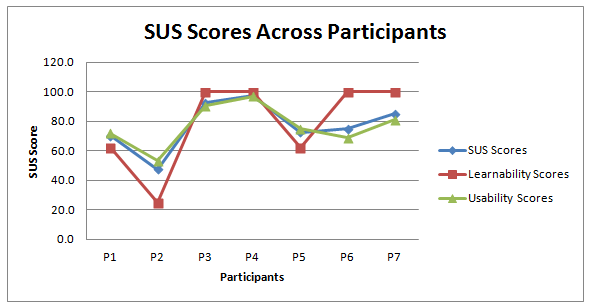Daida
A daily distress (extreme anxiety) awareness mobile application
My Role
- User research
- Wireframes
- Interface mockups
- Cognitive walkthroughs
- Interactive prototypes
- Usability tests

© 2014
This project was for a graduate school course.
Purpose
Daida is a daily distress (extreme anxiety) awareness mobile application. The primary goals of the application are to:
- Support and track the self-monitoring of daily distress
- Estimate the user's future distress levels and provide potential interventions
- Facilitate social support between friends who may be distressed
Methodology
Literature Review
Several scientific papers and web resources were consulted to research prior theories about stress management. Stress has typically been measured physiologically by detecting such factors as heart rate variability (HRV), blood pressure, and skin conductance [1]. Psychological measures (mental and emotional) usually involve self-assessment questionnaires such as the Short Stress State Questionnaire (SSSQ) [2] and Perceived Stress Scale (PSS).
For many decades, researchers have used a technique called Ecological Momentary Assessment (EMA) to gain information about a person’s in-the-moment behavior or experience in the their natural environment. By using an EMA-based measure and observing a person’s history over time, predictive algorithms can be developed to anticipate risks and respond to them before it happens, such as detecting rising stress levels and intervening [3].
Online Survey
An online survey was also conducted to gain general insight about people's stress habits. A total of 32 participants took part in the study.
The survey results revealed that almost half of the participants (14 of 32) experience stress 5-7 days a week. The most common stressors are job pressure and money, followed by relationships and school. Office/work facility and home were the most common stressful environments. 21 of 32 participants stated at least one unhealthy or potentially unhealthy technique that they use for relieving stress, including: drinking alcohol, smoking, avoiding social contact, eating, and not coping at all. Very few participants (2 of 32) stated that they tried to identify their stressor as a way to manage their stress. This is particularly interesting because the first step to stress management, according to experts, is to identify what is causing their stress [4].

Although most of the participants already have coping techniques that help them relieve stress, the most common techniques may not always be applicable during work hours for everyone (i.e. talk to someone, listen to music, exercise). More than half (18 of 32) of the participants are willing to use a mobile application that suggests different ways to properly coping with stress.
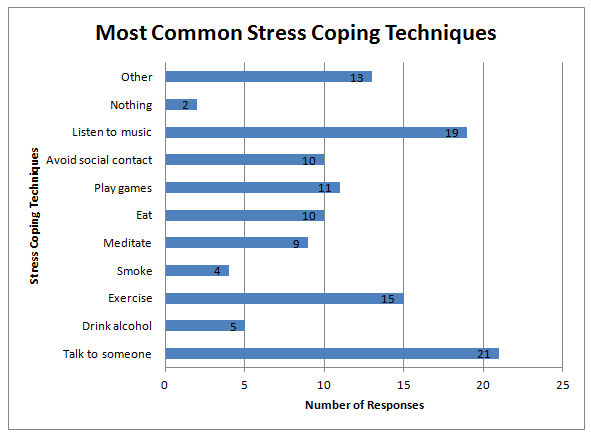
References:
- Staal, M. (2004). Stress, cognition, and human performance: A literature review and conceptual framework. BiblioGov.
- Helton, W. (2004). Validation of a short stress state questionnaire. In Proceedings of the Human Factors and Ergonomics Society Annual Meeting (pp. 1238-1242). doi: 10.1177/154193120404801107
- Shiffman, S., Stone, A., & Hufford, M. (2008). Ecological momentary assessment. Annual Review of Clinical Psychology, 4, 1-32. doi: 10.1146/annurev.clinpsy.3.022806.091415
- Bressert, S. (2006). Simple Steps for Managing Stress in Your Life. Psych Central. Retrieved on September 7, 2013, from http://psychcentral.com/lib/simple-steps-for-managing-stress-in-your-life/000757
Concept
The metaphor for the Daida (Daily Distress Awareness) mobile application is a distress tracker and forecaster.
The application has 3 main concepts:
- Memorability – The user will take a distress questionnaire throughout different time periods each day to calculate their distress level in the moment. They will also identify their main stressor, physical symptom, and location. The user's data will be tracked over time so users can get a summary about their overall distress patterns (i.e. top physical symptoms).
- Predictability - The application will learn the user's distress levels over time and predict their level of distress for the next few days.
- Sociability - The application will allow users to share their distress details with close friends and provide each other with social support.

Design
Low-Fidelity
Low-fidelity prototypes were created and used during cognitive walkthroughs. The walkthrough results revealed usability issues regarding unclear labels and unexpected feedback. Design changes were made based on the results.
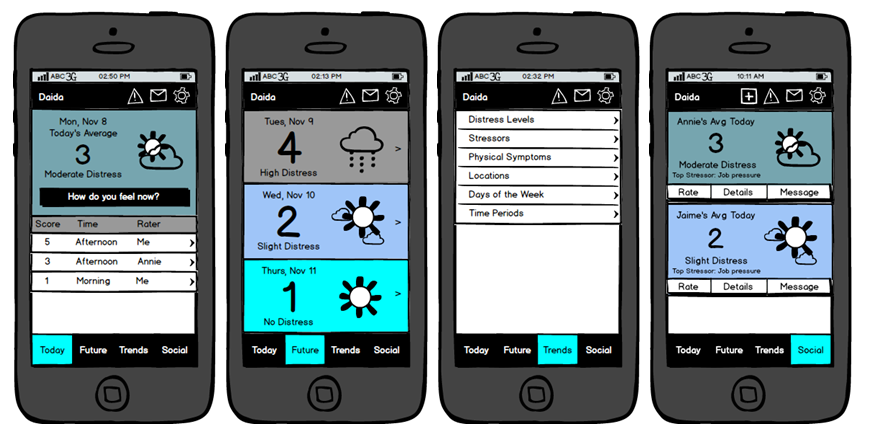
High-Fidelity
A high-fidelity dynamic prototype was developed and used during the formal usability tests/evaluations.

Evaluation
The high-fidelity dynamic prototype was tested with 7 participants (3 females and 4 males between 21-39 years old) using 4 key tasks. The following performance metrics were gathered:
- Task completion rate
- Time-on-task
- Error rate
- Usefulness-of-feature
- System usability scale (SUS)
Task Completion Rate
3 of 4 tasks were at least complete success with assistance. Only 1 particular task (Task 3) was problematic and had the highest number of errors because of the lack of affordance on the buttons.
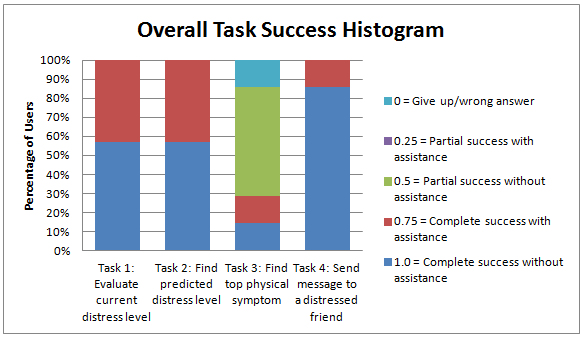
Time on Task
The efficiency across tasks could be improved. Only 1 task was able to stay within its success threshold.
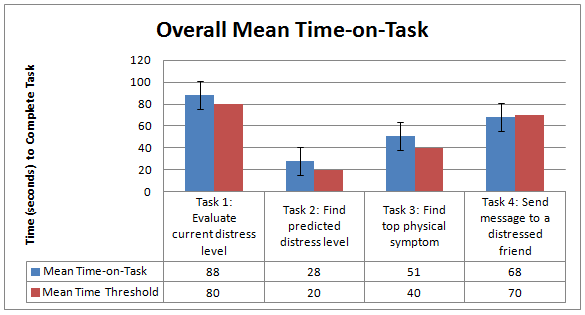
System Usability Scale (SUS)
The mean System Usability Scale (SUS) score is 77.1, which is above average (68.0). Overall, tracking the distress history and providing awareness about a friend's distress levels were found to be the most useful features.
